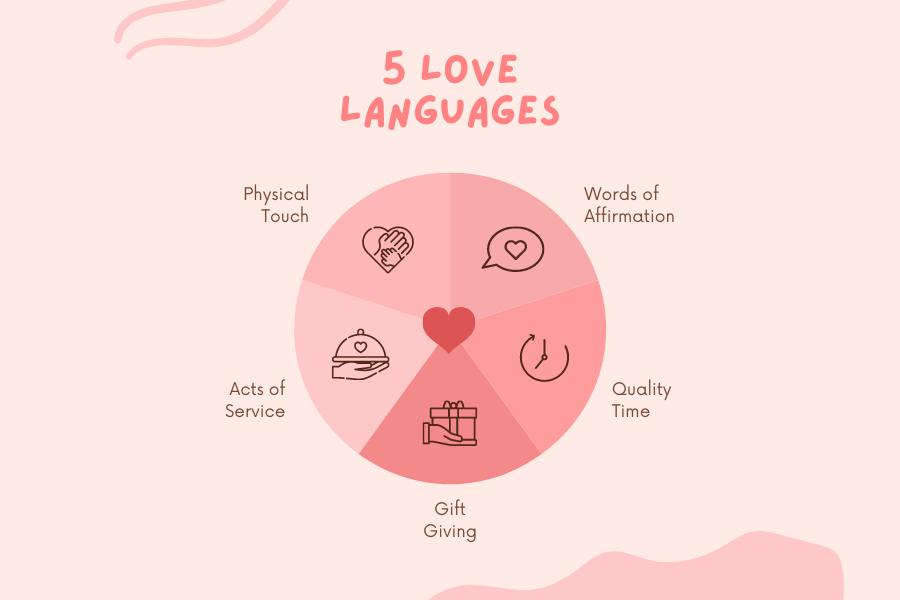In the journey of love and relationships, understanding how you and your partner express and receive love can be a game-changer. This is where the concept of “love languages” comes into play. Coined by Dr. Gary Chapman in his bestselling book The 5 Love Languages: The Secret to Love that Lasts, the idea is simple yet profound: each person has a preferred way of giving and receiving love, and understanding these preferences can lead to stronger, more fulfilling relationships.
What Are the Five Love Languages?
Dr. Chapman identified five primary love languages, each representing a different way of expressing and receiving love:
1. Words of Affirmation:
• For some, words hold incredible power. Compliments, verbal encouragement, and expressions of appreciation are the keys to their heart. Simple phrases like “I love you,” or “You mean so much to me,” can make them feel cherished and valued.
2. Acts of Service:
• Actions often speak louder than words. For those who value acts of service, nothing says “I love you” more than someone going out of their way to help them. Whether it’s doing the dishes, running errands, or helping with a project, these acts show care and commitment.
3. Receiving Gifts:
• It’s not about the material value but the thoughtfulness behind the gift. For some, receiving a meaningful gift is a tangible expression of love. It shows that their partner was thinking of them and took the time to choose something special.
4. Quality Time:
• Undivided attention and meaningful time together are vital for those who value quality time. Whether it’s a quiet evening at home or an adventurous day out, the key is being fully present and engaged with your partner.
5. Physical Touch:
• Physical touch is a powerful way to communicate love. For some, it’s essential to feel connected through touch, whether it’s holding hands, hugging, or cuddling. These small gestures can convey affection and reassurance.
How Understanding Love Languages Can Strengthen Your Relationship
Understanding your partner’s love language—and your own—can transform how you relate to each other. Here’s how:
1. Enhances Communication:
• Knowing each other’s love languages helps you communicate more effectively. Instead of guessing what might make your partner feel loved, you can express affection in ways that resonate deeply with them.
2. Prevents Misunderstandings:
• Misunderstandings often arise when partners express love in different ways. For example, one partner might show love through acts of service, while the other craves verbal affirmations. Understanding love languages helps bridge this gap, reducing feelings of neglect or unappreciation.
3. Strengthens Emotional Connection:
• When both partners feel loved and appreciated in their preferred way, it naturally strengthens the emotional bond. This leads to a more satisfying and intimate relationship, where both partners feel understood and valued.
4. Encourages Mutual Growth:
• Learning about love languages encourages personal growth. It invites you to step outside of your comfort zone and express love in ways that might not come naturally, fostering a deeper connection and a more harmonious relationship.
5. Builds Lasting Love:
• Love languages are not a one-time fix but a lifelong practice. As your relationship evolves, revisiting and adapting to each other’s love languages can help maintain and deepen your connection over time.
Practical Steps to Apply Love Languages in Your Relationship
1. Discover Your Love Languages:
• Take the time to discover your own love language and that of your partner. Dr. Chapman’s book includes a quiz, but simply observing what makes each of you feel most loved can also provide insight.
2. Communicate Openly:
• Discuss your love languages with each other. Share what makes you feel loved and listen to your partner’s needs without judgment. This open dialogue lays the groundwork for a stronger connection.
3. Be Intentional:
• Make a conscious effort to express love in your partner’s preferred love language. It might feel unnatural at first, especially if it’s different from your own, but over time, it will become more intuitive.
4. Be Patient and Understanding:
• It’s important to remember that relationships take work, and adjusting to each other’s love languages is a process. Be patient with each other, and understand that it’s okay to make mistakes along the way.
5. Reevaluate Over Time:
• Love languages can evolve as relationships grow and change. Periodically check in with each other to ensure that you’re still meeting each other’s needs and to make adjustments as necessary.
Understanding and applying the concept of love languages can be a powerful tool in building a deeper, more meaningful relationship. By recognizing and honoring the way your partner feels most loved, you create a foundation of mutual respect, appreciation, and connection. Love languages remind us that love is not just about feelings but about action—consistently choosing to express love in ways that matter most to your partner. With this understanding, you can nurture a relationship that not only endures but thrives.
